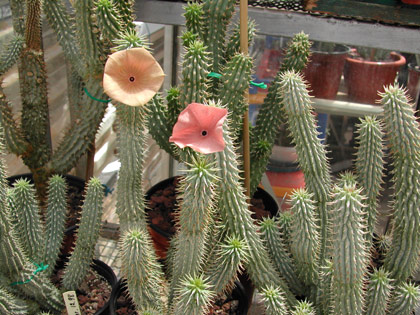Hoodia Gordonii
Hoodia are natives to the semi-deserts of S. Africa and Namibia.
There are about 20 species in this family. The plant form a clump of short, upright stem in pale green. These plants are very difficult to grow and need a lot of attention and control of watering, temperature and sunlight.
The H. gordonii has become lately in the spot light of a public interest as a supplement for diet by suppressing hunger and thirst.
Since time immemorial, the succulent Hoodia has grown in the Kalahari desert in southern Africa and has been eaten by the San bushmen during their long hunting trips. Its juice takes the edge off appetite and thirst, and has enabled the hunters to respect their tradition of bringing home their entire catch, without eating of it on the way.
The San Bushmen of the Kalahari, one of the world's oldest and most primitive tribes, had been eating the Hoodia for thousands of years, to stave off hunger during there trips they cut off a stem of the Hoodia cactus about the size of a cucumber and munch on it over a couple of days.

The Haioms of northern Namibia still use Hoodia sap to treat allergic reactions in the eyes, and to treat severe stomach pain they boil Hoodia pieces in water and drink the brew. The Anikhwe of northern Botswana feed children who "eat too much" pieces of Hoodia to make them eat less. Already decades ago obese members of the Khomani community of north-western South Africa were eating the Hoodia to slim down or to maintain a high energy level.
In the old days people consumed the plant to meet the requirements of a healthy body whereas today overweight young people do so to slim down to meet the requirements of fashion. Now the Hoodia, which grows to 6ft - taller than the bushmen themselves - is in the centre of public interest the cactus also attracted the interest of the Western drug industry. Extracts from the Hoodia plant have shown in clinical trials on obese subjects to reduce caloric intake by 30% to 40%. Significant weight loss has resulted from such a drop in caloric intake.
|